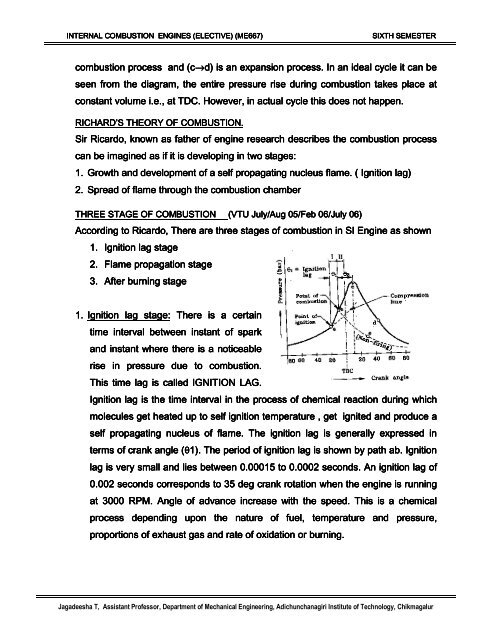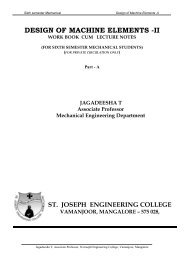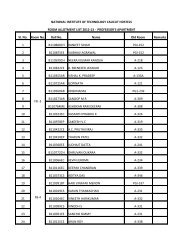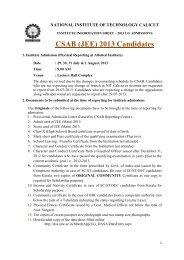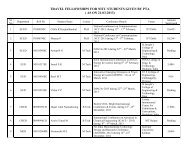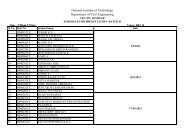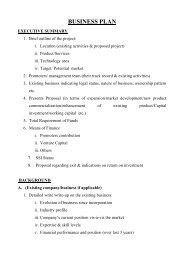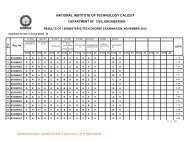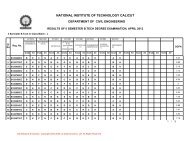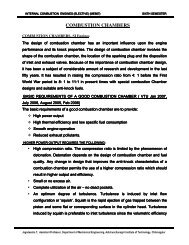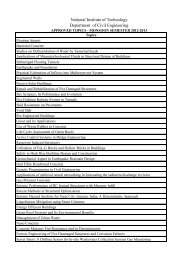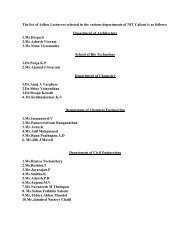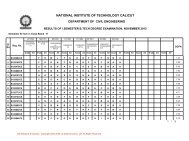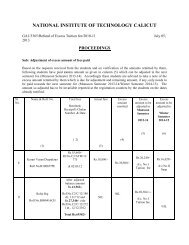combustion process in si engines - National Institute of Technology
combustion process in si engines - National Institute of Technology
combustion process in si engines - National Institute of Technology
You also want an ePaper? Increase the reach of your titles
YUMPU automatically turns print PDFs into web optimized ePapers that Google loves.
INTERNAL COMBUSTION ENGINES (ELECTIVE) (ME667)<br />
SIXTH SEMESTER<br />
<strong>combustion</strong> <strong>process</strong> and (c→d) is an expan<strong>si</strong>on <strong>process</strong>. In an ideal cycle it can be<br />
seen from the diagram, the entire pressure rise dur<strong>in</strong>g <strong>combustion</strong> takes place at<br />
constant volume i.e., at TDC. However, <strong>in</strong> actual cycle this does not happen.<br />
RICHARD’S THEORY OF COMBUSTION.<br />
Sir Ricardo, known as father <strong>of</strong> eng<strong>in</strong>e research describes the <strong>combustion</strong> <strong>process</strong><br />
can be imag<strong>in</strong>ed as if it is develop<strong>in</strong>g <strong>in</strong> two stages:<br />
1. Growth and development <strong>of</strong> a self propagat<strong>in</strong>g nucleus flame. ( Ignition lag)<br />
2. Spread <strong>of</strong> flame through the <strong>combustion</strong> chamber<br />
THREE STAGE OF COMBUSTION (VTU July/Aug 05/Feb 06/July 06)<br />
Accord<strong>in</strong>g to Ricardo, There are three stages <strong>of</strong> <strong>combustion</strong> <strong>in</strong> SI Eng<strong>in</strong>e as shown<br />
1. Ignition lag stage<br />
2. Flame propagation stage<br />
3. After burn<strong>in</strong>g stage<br />
1. Ignition lag stage: There is a certa<strong>in</strong><br />
time <strong>in</strong>terval between <strong>in</strong>stant <strong>of</strong> spark<br />
and <strong>in</strong>stant where there e is a noticeable<br />
rise <strong>in</strong> pressure due to <strong>combustion</strong>.<br />
This time lag is called IGNITION LAG.<br />
Ignition lag is the time <strong>in</strong>terval <strong>in</strong> the <strong>process</strong> <strong>of</strong> chemical reaction dur<strong>in</strong>g which<br />
molecules get heated up to self ignition temperature , get ignited and produce a<br />
self propagat<strong>in</strong>g nucleus <strong>of</strong> flame. The ignition lag is generally expressed <strong>in</strong><br />
terms <strong>of</strong> crank angle (θ1). (<br />
The period <strong>of</strong> ignition lag is shown by path ab. Ignition<br />
lag is very small and lies between 0.00015 to 0.0002 seconds. An ignition lag <strong>of</strong><br />
0.002 seconds s corresponds to 35 deg crank rotation when the eng<strong>in</strong>e is runn<strong>in</strong>g<br />
at 3000 RPM. Angle <strong>of</strong> advance <strong>in</strong>crease with the speed. This is a chemical<br />
<strong>process</strong> depend<strong>in</strong>g upon the nature <strong>of</strong> fuel, temperature and pressure,<br />
proportions <strong>of</strong> exhaust gas and rate <strong>of</strong> oxidation or burn<strong>in</strong>g.<br />
Jagadeesha T, As<strong>si</strong>stant Pr<strong>of</strong>essor, Department <strong>of</strong> Mechanical Eng<strong>in</strong>eer<strong>in</strong>g, Adichunchanagiri <strong>Institute</strong> <strong>of</strong> <strong>Technology</strong>, Chikmagalur


